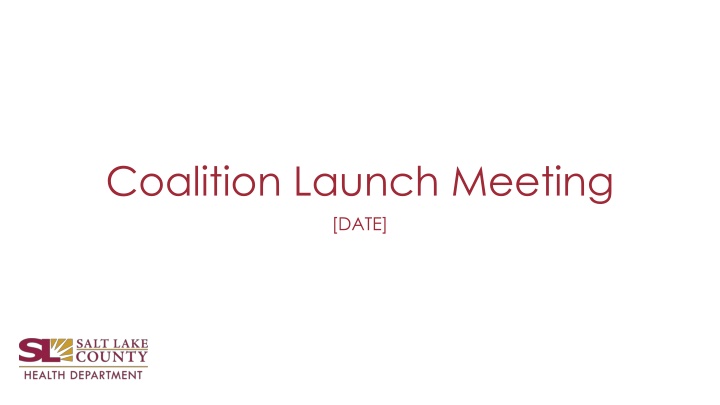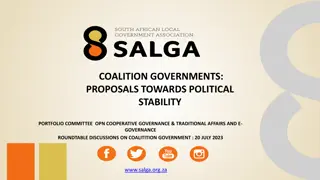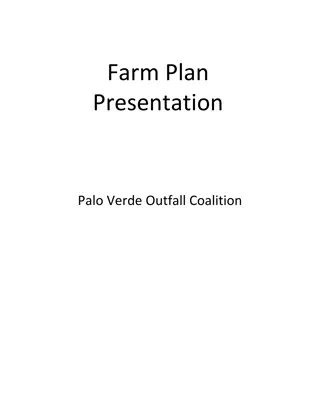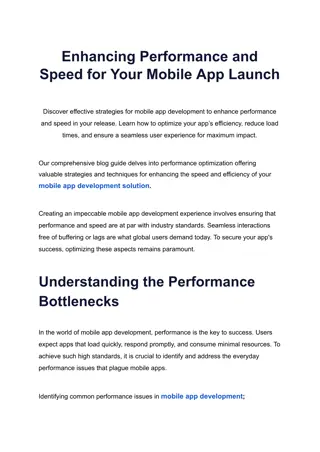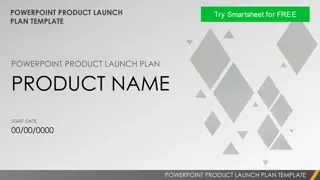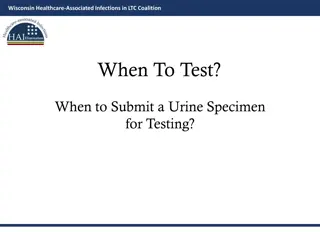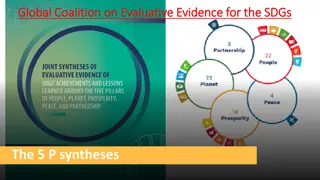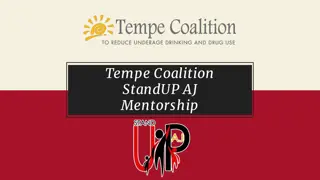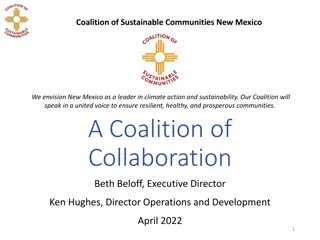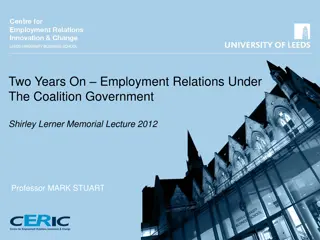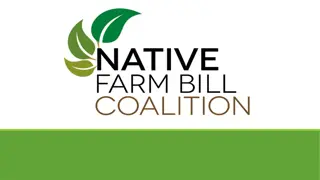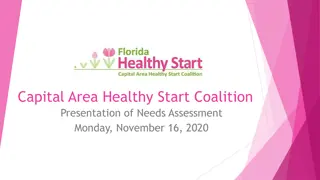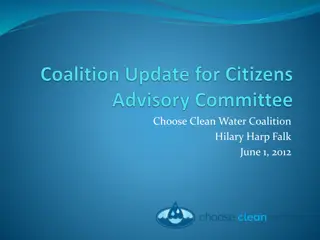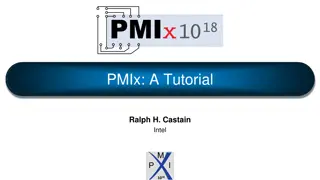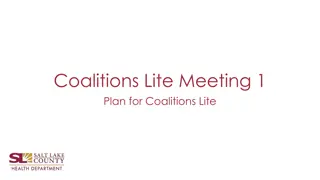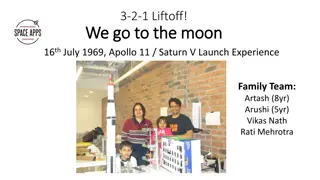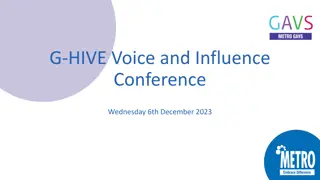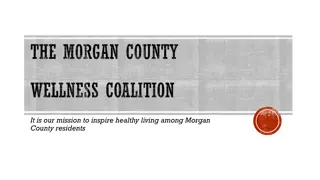Coalition Launch Meeting Agenda & Progress Overview
Agenda for a coalition launch meeting includes welcome, introductions, overview, progress review, leadership election, workgroups establishment, vision statement brainstorming, and next steps. The meeting focuses on organizing the community, assessing readiness, engaging key leaders, and organizing the coalition, following a specific framework. Training on public health, prevention science, and evidence-based community coalitions is also included.
Download Presentation

Please find below an Image/Link to download the presentation.
The content on the website is provided AS IS for your information and personal use only. It may not be sold, licensed, or shared on other websites without obtaining consent from the author.If you encounter any issues during the download, it is possible that the publisher has removed the file from their server.
You are allowed to download the files provided on this website for personal or commercial use, subject to the condition that they are used lawfully. All files are the property of their respective owners.
The content on the website is provided AS IS for your information and personal use only. It may not be sold, licensed, or shared on other websites without obtaining consent from the author.
E N D
Presentation Transcript
Coalition Launch Meeting [DATE]
Welcome, Introductions, & Overview 20 minutes
Introductions Name Affiliation Check-In Question: [ADD QUESTION]
Agenda Meeting logistics and overview (20 minutes) Review progress on forming our coalition (10 min) Train participants on foundational coalition issues (30 minutes) Elect Coalition Leadership (10 minutes) Take a short break! (10 minutes) Name the Coalition (15 minutes) Establish Workgroups (30 minutes) Brainstorm Ideas for a Vision Statement (15 minutes) Wrap Up and Next Steps (10 minutes)
Coalition Progress 10 minutes
Coalition Progress Standard 1: Organize the Community Standard 2: Assess the community's readiness Understand how ready the community is to work collaboratively and work through identified issues; Select your coalition framework Standard 3: Engage a Key Leader Standard 4: Organize the Coalition Identify people and organizations to work on the coalition Recruit coalition members and hold coalition launch meeting (this meeting!) Involve key leaders 1 month (could be merged with phase 2) 1-3 months 2-4 months 2-4 months Are there any incomplete steps we need to circle back for?
[ENTER SELECTED COALITION FRAMEWORK NAME] [ENTER INFORMATION ABOUT YOUR SELECTED COALITION FRAMEWORK, SUCH AS BASIC TIMELINE, PROCESS, AND REASONS FOR SELECTION]
Coalition Training Public health, prevention science, and evidence-based community coalitions 30 minutes
Public Health Defined The science and art of preventing disease, prolonging life, and promoting health through the organized efforts and informed choices of society, organizations, public and private communities, and individuals. CEA Winslow Photo: IF Fisher and EL Fisk *Centers for Disease Control and Prevention (CDC). Introduction to Public Health. In: Public Health 101 Series. Atlanta, GA: U.S. Department of Health and Human Services, CDC; 2014. Available at: https://www.cdc.gov/training/publichealth101/public-health.html. Winslow CEA. The untilled field of public health. Mod Med 1920;2:183 91. 11
The Mission of Public Health Fulfilling society s interest in assuring conditions in which people can be healthy. Institute of Medicine Public health aims to provide maximum benefit for the largest number of people. World Health Organization
A Public Health Approach Surveillance / Data Risk Factor Identification Intervention Implementation 13
Partners in the Public Health System Schools, churches, service providers, volunteers, parents, youth, law enforcement, etc.! Clinical Care Delivery System Community Government Public Health Infrastructure Employers and Businesses Ensuring the Conditions for Population Health Academia The Media Institute of Medicine. The future of the public's health in the 21st century. Washington, DC: The National Academies Press; 2002. 14
What Determines the Health of a Population? Genes and Biology Social/Societal Characteristics; Total Ecology Health Behaviors Medical Care 15 Centers for Disease Control and Prevention. Social determinants of health. http://www.cdc.gov/socialdeterminants/FAQ.html.
Knowledge Check Fill in the blank with the correct answer. A. groups of people B. individuals groups of people Public health aims to provide ___________________ with the right to be healthy and live in conditions that support health. 16
Knowledge Check Fill in the blank with the correct answer. A. methodical B. ad-hoc methodical Public health uses a ____________ approach to understanding problems, investigating risk factors, and selecting strategies to improve community health. 17
Knowledge Check Fill in the blank with the correct answer. A. only government B. many stakeholders many stakeholders Public health needs ___________________ to support our communities health. 18
Prevention Science Communities That Care: http://vimeo.com/71139765?width=500 Prevention science is the development, implementation, and evaluation of evidence-based programs and strategies that reduce risk factors and enhance protective factors to improve the health and well- being of individuals, families, communities, and organizations.
Evidence-Based Community Coalitions Communities That Care (CTC) 49% less likely to initiate gateway drug use 25% reduction in delinquent behavior 18% less likely to initiate antisocial behavior 11% lower lifetime incidence of violence Societal savings: $1 invested into CTC system = $5.31 societal savings Strategic Prevention Framework (SPF) Drug Free Communities (DFC) Coalitions Lite (SLCoHD s)
Coalition Roles Coalition Members: Voting members of the coalition Coalition Leadership: Chair, Co-Chair, Secretary, Treasurer Executive Committee: Coalition leadership + workgroup chairs Stakeholders: Anyone who has a stake in the coalition s work, including those impacted by your work Key Leaders: Community leaders with influence and access to resources who can help you with resources, connections, and feedback
Elect Coalition Leadership 10 minutes
Elect Coalition Leadership Chair The Board Chair puts the agendas together for coalition meetings and leads the meetings. They are responsible for ensuring the coalition is making progress in their work. If the coalition has a coordinator, the Chair works closely with the coordinator on these tasks. The Chair is the primary representative for the coalition and is part of the Executive Committee. Secretary Treasurer Co-Chair The Secretary takes notes at full coalition meetings. They are responsible for posting the notes in the shared folder and sending them out to coalition members. The Secretary is part of the Executive Committee. If the coalition has funding, you may also consider electing a Treasurer who can track spending and ensure spending is within the grant rules. If there is a Treasurer, they are part of the Executive Committee. The Co-Chair fills in for the Chair in their absence and will generally become the next Chair once there is a change in leadership. The Co-Chair is part of the Executive Committee.
Nominations? (Hint: It s ok to nominate yourself!!)
Break (10 minutes)
Name the Coalition 15 minutes
Name Your Coalition! Why are you interested in joining this coalition? What is motivating you to show up today? Based on people s reasons for joining the coalition, what are some possible ideas for coalition names? Vote! Raise your hand for your favorite name.
Establish Workgroups 30 minutes
Workgroups Board Development How do we operate internally? Recruitment* and Outreach How do we engage and communicate externally? Data and Resource Assessment How do we focus our efforts? Funding and Finance / Sustainability How do we fund our efforts? Youth Involvement How do we get youth involved? Executive Committee How do we lead the coalition? Workgroup Description Information Sheet * Board member recruitment can be shared between the Board Development workgroup and the Outreach workgroup. One workgroup must claim primary responsibility, but both will have a role to play. Coordination between the two workgroups regarding recruitment is important.
Workgroup Exercise (20 mins) 1. Assign each workgroup to a different part of the room 2. Each participant should move to the workgroup they would most like to work with. If you would like to participate in more than one workgroup, sit with the group you are most interested in or with the group that has the fewest people. You do not need to be an expert in the topic to join the workgroup! However, if you have an expertise, please consider going with the relevant workgroup. 3. Each group discusses their workgroup s areas of responsibilities and a few initial tasks. 4. Each workgroup elects a chair. The workgroup chairs are part of the Executive Committee. 5. Each group should decide on a meeting schedule. Most workgroups choose to meet monthly.
Brainstorm A Vision Statement 15 minutes
Vision Points In 5 minutes, write on sticky notes (one idea per note): What would our community: look like, sound like, smell like, feel like, if our coalition were successful.
Wrap Up & Next Steps 10 minutes
Next Steps Schedule your next coalition meeting. Ad-hoc Vision Workgroup: Finalize the vision points with ideas from the meeting. Be ready to share the draft with coalition at the next meeting. Flip charts from both section 6 and section 7 should be given to the Vision workgroup to use in crafting the vision points. Board Development Workgroup: Start outlining policies and procedures, including decision-making and voting processes, how to vote in new members, quorums, etc. Recruitment and Outreach Workgroup: Develop a recruitment plan and an orientation for new members. Youth Involvement Workgroup: Meet with teachers, youth groups, sports facilities, clubs, etc. to understand how you can work together for youth involvement in the coalition. Funding and Finance Workgroup: Start researching funding opportunities and resource needs. Executive Committee: Schedule monthly meetings. Several days before coalition meetings is a good time to meet and review agendas. Notetaker sends notes out to coalition and saves the notes in the shared drive. One person to create a coalition account on a shared drive and set up shared folders. Board Chair to send out calendar invite for next meeting. Board Chair to draft agenda for next meeting. Any standards that we need to circle back on.
Check-Out Discussion: How did this meeting go? What worked well or didn t work well with the meeting? How can we run our future meetings better?
